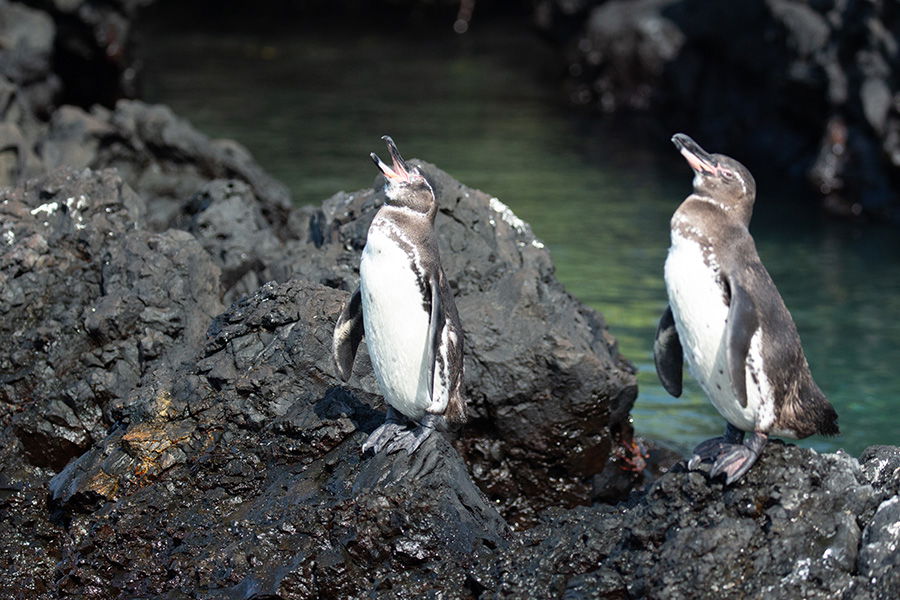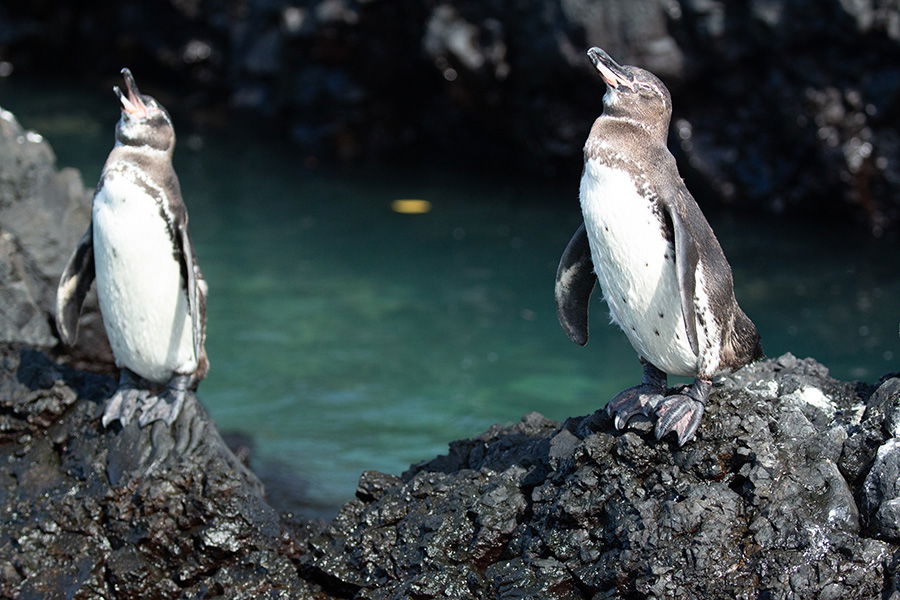Galápagos Penguin
Have you ever heard someone say that penguins are only found south of the equator? Indeed, you won’t see penguins mingling with polar bears in the Arctic Circle, and 17 of the 18 modern penguin species do follow that rule. But one species defies the norm—the Galápagos penguin.
As their name suggests, Galápagos penguins are native to the Galápagos Islands off the coast of Ecuador in the Pacific Ocean, primarily the islands of Fernandina and Isabela. Small populations also live in Bartolomé, Floreana, Santa Cruz, and Santiago. The island of Isabela is the largest of the Galápagos Islands and the northern tip crosses into the Northern Hemisphere. Therefore, penguins who live along the northern coastline of Isabela live north of the equator!
I was lucky enough to spend two weeks in the Galápagos Islands during the summer of 2024 and see these peculiar penguins for myself. I even got to swim with them in the coastal waters of Isabela and Floreana. Due to their extremely limited range, they are an endangered species, and scientists estimate that fewer than 2,000 of these birds exist.1, 2 I was so excited to see and swim with one of the rarest birds on earth.
Galápagos penguins keep to the western Galápagos Islands to stay in the cooler waters of the Cromwell and Humboldt Currents. Scientists believe these penguins originally arrived in the Galápagos via the Humboldt Current, which swept their ancestors up from South America and away from other penguin populations. Because of their isolation and pressures from a unique ecosystem, they began adapting into a new species.
Galápagos penguins belong to the penguin kind. When God created birds on day five of creation week, he made them according to their kinds (Genesis 1:20–23). Each kind started with vast genetic potential. As populations of each kind ended up in different habitats, different traits were selected for from within that genetic potential to help them survive. But the penguins are still penguins. They cannot turn into a new kind of animal.
Small animals lose body heat faster than large animals, so the Galápagos penguins shrank to stay cool in the warmer climate and are now one of the smallest penguin species. They stand an average of 20 inches (50 cm) tall and weigh only 4.4–8.8 pounds (2–4 kgs). When on land, they keep their feet covered to prevent sunburn, and they keep their eggs and chicks from overheating by hiding them in rock crevices and lava caves. Like dogs, they will also pant to cool their airways through evaporation. They can also just jump in the ocean! While resting on land, they often stand with their flippers spread to the side to help them lose heat. Despite the warm days during my visit, the water around Floreana and Isabela where I swam with the penguins was refreshingly cool. Those cold waters are full of nutrients, which attract the penguins’ favorite food: fish and crustaceans. Their powerful flippers and streamlined bodies allow them to zip through the water as fast as 22 mph (35 kph) to catch speedy prey.
Because the Galápagos ecosystem is harsh and food availability is uncertain, Galápagos penguins may breed throughout the year. Most penguin species stick to one breeding season each year, but Galápagos penguins may breed two or three times a year if food is abundant. Pairs often mate for life and work together to raise their chicks. During very warm weather, they may not breed at all because food becomes scarce. The worst of these warming events is called El Niño, a phenomenon when Pacific trade winds weaken causing the ocean surface temperatures to warm, halting the nutrient-rich cold water upwellings that marine life relies on for survival. El Niños are devastating for Galápagos life, and during strong El Niños, 50–77% of the Galápagos penguin population has been lost.
The small population of Galápagos penguins is also threatened by pollution, getting caught in fishing nets, and being killed by invasive species. Although the Ecuadorian government is working hard to get rid of animals introduced to the Galápagos Islands by humans, invasive cats, dogs, and rats hunt penguins, destroy their eggs, and spread diseases. Additionally, because their population is so small, they have limited genetic diversity, which makes them more susceptible to stressors.
When I visited the penguins in the Galápagos, we had very strict rules about interacting with them to ensure they stayed safe and healthy and were not harmed by tourism. We had to keep a six-foot (1.8 m) distance between us and the wildlife, although the wildlife could approach us. If they did, we could not touch them or harass them in any way. Although it was tempting to reach out and pet them when they swam up to us, respecting their space and considering their safety was more important. If every person who visited the Galápagos tried to touch them, the penguins could be hurt by people or die from the stress. With so few penguins left, people should do their best to preserve them.
Psalm 104:24–25 says, “O Lord, how manifold are your works! In wisdom have you made them all; the earth is full of your creatures. Here is the sea, great and wide, which teems with creatures innumerable, living things both small and great.” Humans have been given an important task to care for God’s creatures, which means protecting these remarkable little penguins so they stick around for years to come.
Footnotes
- Oceana, “Galapagos Penguin,” accessed October 1, 2024, https://oceana.org/marine-life/galapagos-penguin/.
- IUCN Red List, “Galapagos Penguin,” accessed October 1, 2024, https://www.iucnredlist.org/species/22697825/182729677.
- © 2025 Answers in Genesis
- Privacy Policy
- Contact
- About








